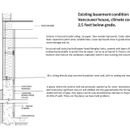Installing Exterior Insulation on Foundation Stem Wall
Hi there,
Thankyou so much for this valuable resource! I became a GBA member only recently and have been busily devouring all the incredible information and insights shared here as I undertake an insultation upgrade to our home’s existing basement walls.
I think I’ve gleaned the best approach from the many posts and drawings shared here, but I haven’t found reference to my specific situation. We are in Vancouver, British Columbia (US climate zone 4) and have a 1968 “Vancouver Special” (simple 2 storey home typically built as slab on grade but in our case 2.5’ below grade). We have 7.5’ high basement ceilings, but the bottom 2.5’ of the wall is the concrete foundation stem wall, atop which sits the insulated stud assembly for the upper 5’ of the wall. We’ve been having moisture and mold issues and are taking steps to remediate including:
addressing moisture entry by fixing some cracks in the foundation wall;
addressing moisture diffusion (applying a chemical vapour barrier (silicate – PIM+, followed by epoxy) to the slab and foundation walls, and
addressing condensation by improving wall insulation and eliminating the significant thermal bridging happening between the lower foundation wall and the interior drywall.
For this last task, I’m wondering if anyone has advice on how I should approach insulating this wall section given the awkward part foundation wall / part insulated stud wall configuration.
I’ve attached a diagram showing the existing condition and my proposed changes which involve ripping out the existing furring strips, attaching a continuous layer of 1” rigid foam against the concrete stem wall and all the way up to the ceiling, reattaching 1×3” wood furring strips (or considering metal furring strips to minimize future moisture / rot issues?), and then hanging the new non-paper faced drywall.
My main questions are:
· Do I need to consider any additional exterior wall treatments for moisture/air barrier beyond caulking and foaming up cracks and holes? Presumably I want the wall to be able to breathe to the outside so caulking cracks followed by Roxul batts should be adequate?
· Should I extend the 1” rigid foam all the way to ceiling so as to have a wall assembly with a continuos layer of taped and sealed rigid foam acting as vapour barrier in lieu of poly sheeting? Since I’m rebuilding the furring framing to accommodate this in the lower wall section, it seems like I might as well do it all the way up. Or alternately I could just install a poly vapour barrier in this upper wall section? One of my key questions is: if I do the continuous rigid foam from slab to ceiling, do I need a poly vapour barrier anywhere if I’m diligent about sealing the continuous layer of rigid foam?
Many thanks GBA community for any advice and assistance!
Cheers,
Andrew McCurran
Vancouver, BC
GBA Detail Library
A collection of one thousand construction details organized by climate and house part











Replies
Andrew,
I would go with what you propose for the slab and stem-walls. I would then fur out the upper stud walls so they were co-planar to eliminate the ledge (see second paragraph below). Your biggest gains will be through air-sealing. For that you can rely on the foam, or add a layer of poly if you think it may be easier to get continuous.
You have a few choices in how you fur out the stud walls. Most effective would be to use a continuous layer of foam. You can also put strips of foam on the studs and plates to form a Bonfiglioli wall, or just strap with wood. The two first options make moving out the electrical boxes more difficult.
Thanks so much Malcolm. I’ll investigate those different furring options.
To clarify your comment in the first paragraph, for added air seal certainty do you think it advisable to add a layer of poly directly behind the foam for the upper portion of the wall Or in front of the foam (between foam and drywall)? I’ve heard different opinions about use of poly and concrete walls - but maybe this changes if it is in front of a continuous rigid foam layer.
I’m generally a bit confused as to where the air sealing layer is best located. Presumably I want the whole wall assembly behind the vapour barrier (rigid foam or poly) to be able to breathe outwards to the exterior wall. Right now there is essentially a paper / cardboard layer (so vapour permeable, but does some work at keeping out drafts?) holding in the old fibreglass batts. But in my new proposal you think I’d be okay going from exterior wood lap wall (with improved caulking of gaps) to two layers of roxul, to rigid foam, to poly, to drywall?
Thanks for the clarification!
Andrew
Andrew,
The air-sealing done at the exterior is primarily to stop wind-washing of the batt insulation. The primary air-barrier will be the poly or foam on the interior face.
Because it spans the whole wall continuously, poly is easier to work with as an interior air barrier than foam, but foam can work well on its own too. It doesn't matter what the relationship of the poly is to any foam you add - behind or in front - as both materials are acting in the same way as combined interior air-vapour barriers in your assemblies.
That same advice is true of the various layers at the stem-walls. Poly either side of the foam is fine. It is only a problem when you are also including permeable (fluffy) insulation on the interior of those walls. Then they need to dry to the inside, and poly stops that.
Thanks Malcolm - that’s really helpful.